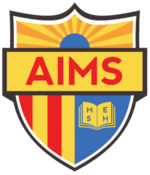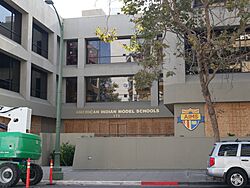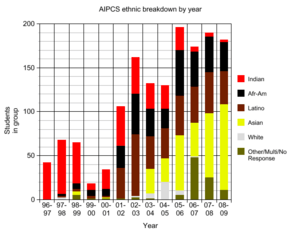American Indian Model Schools facts for kids
Quick facts for kids American Indian Public Charter School II |
|
|---|---|
 |
|
 |
|
| Information | |
| Faculty | 23 |
| Grades | K–8 |
| Enrollment | 616 (2015) |
The American Indian Model Schools (AIM Schools) is a group of charter schools in Oakland, California. It started with the American Indian Public Charter School (AIPCS) in the late 1990s. This first school was a middle school created to help Native American students.
In 2007, the system grew to include another middle school and a high school. The main campus is in the Laurel area. It has AIPCS (grades 5–8) and American Indian Public High School (AIPHS) for high school students (grades 9–12). AIPHS students can also take some classes at Merritt College.
Another school, American Indian Public Charter School II (AIPCS II), teaches grades K–8. It is located at a different campus in Oakland's Chinatown. By 2012, most students in the AIM schools (about 90%) were Asian American.
The Oakland Unified School District (OUSD) gave the school system its charter, which is like a permission slip to operate. The AIM school system has its own school board and rules.
Ben Chavis, a Native American professor, led AIPCS. Under his leadership from 2000 to 2007, students made great progress in their school scores. More students also joined the school. The first middle school, AIPCS, even received national recognition in 2007.
Chavis's strict discipline methods caused some disagreements. He resigned as principal in 2007. However, the school board decided to keep him in an important leadership role for the school system. In 2012, Chavis left his ties with the charter system and moved back to North Carolina.
For a while, the school system's charter from the OUSD was at risk. But in 2012, a court allowed it to keep operating. Because of new management and students' good academic results, the Model School system's charter was renewed in 2013 for five years. This renewal also allowed AIPCS II to expand and teach grades K–4.
Contents
About AIM Schools
The American Indian Public Charter School (AICPS) started in 1996. It was a small charter school meant for Native American students in Oakland. At first, the school struggled to improve student performance.
In 2000, Ben Chavis became the principal. He brought in new teachers and set up strict rules for discipline and studying. Over the next few years, test scores improved a lot, and more students enrolled. The student population also became more diverse, with more students from Asian, African American, and Latino backgrounds.
The AIM system was created in 2007. It added two more charter schools: another middle school and a high school. These schools were praised for their academic success. However, Chavis's discipline system and how he treated students and teachers caused some debate. He stepped down in 2007 but still had influence at the schools.
In 2012, a state review found that Chavis had directed school payments to businesses he and his wife owned. The school board was also criticized for not managing money well. The Oakland School Board had tried to stop AIPCS II from operating in 2011. However, the school system got a court order to keep its three schools open.
School History
The American Indian Public Charter School opened in 1996. It aimed to help Native American students in Oakland, California. Historically, Native American students had lower academic results in public schools.
When the school first started, it had many staff changes and not enough money for books and computers. In 2000, the Oakland Unified School District (OUSD) thought about closing the school. A newspaper reported that the school, with only 37 students, was "sinking fast."
Evelyn Lamenti from OUSD asked Ben Chavis to be the principal. Chavis had been a professor and was interested in charter schools. He became the head of the school in 2000. He hired new teachers who believed in the students' potential. By 2001, he had replaced almost all the teachers.
By 2002, the school's enrollment had tripled, and test scores were rising. In 2006–2007, Chavis and the board created the American Indian Model School system. They added the American Indian Charter High School in September 2006.
In 2006, AICPS became the first public school in Oakland to win the National Blue Ribbon Award. This award recognizes schools for high academic performance.
Some parents and teachers complained about Chavis's behavior. In 2007, OUSD officials asked the AIM board to address these issues. Chavis resigned on March 15, 2007, but remained involved as an "advisor emeritus."
Janet Roberts, a former teacher, took over as head of the school system. She noted that the schools continued to succeed academically even after Chavis left. In June 2009, the first class of 18 students graduated from AIPHS. All of them were accepted into good colleges.
Charter Renewal and Challenges
In 2011, a state review began looking into the American Indian Model Charter Schools' finances. This was due to a complaint about how money was being managed.
During the 2012 process to renew the charter for AIPCS II, the Oakland Office of Charter Schools (OCS) found some issues. They noted problems with how the school was run and how its money was handled. However, OCS also recognized that AIPCS II was meeting its goals for student achievement.
On April 4, 2012, the OUSD board discussed renewing the AIPCS II charter. OCS suggested denying the renewal. They pointed out that Chavis had been involved in financial dealings with the school that raised concerns.
Despite these issues, the OUSD board voted 4–3 to renew the AIPCS II charter for another five years. This decision was made because of the students' strong academic results and the support from many parents, staff, and students. The renewed charter also allowed AIPCS II to expand to include elementary grades K–4.
In June 2012, the state audit report was published. It listed evidence of financial problems and suggested sending the findings to local authorities. The president of the AIM Schools Board resigned.
On September 27, 2012, the Oakland School Board voted to issue a "Notice of violation" to the American Indian Public Charter School. The school's board then sued the Oakland School Board, saying it was an attempt to take over the school.
On January 23, 2013, the OUSD Board voted to try and revoke the AIMS charter. However, on July 15, 2013, a judge allowed all three campuses to keep operating. Because of the students' good scores and changes in the school's management, the AIMS charter was renewed for five years. On January 25, 2017, the OUSD Governing Board renewed the charter for another five years, until June 30, 2022. Due to changes in California law, AIPCS II's charter was automatically extended to June 30, 2025.
School Campuses
As of 2017, the AIM system has three schools:
- American Indian Public Charter School (AICPS), a middle school (grades 5–8).
- American Indian Public Charter School II (AIPCS II), for grades K–8.
- American Indian Public High School (AIPHS), a high school (grades 9–12).
The school system has two main locations. The original AICPS and the main campus of AIPHS are in a converted church in the Laurel area of Oakland. AIPCS II is located at a different campus in Oakland's Chinatown. Students from AIPHS who take college classes also attend some lessons at the Merritt College campus.
AICPS II used to share a campus with Little Hands School. It serves students living in Chinatown and the Lake Merritt area. AICPS also accepts students from other parts of Oakland and even outside of Oakland.
How the Schools Operate
In 2009, Kevin Drum from Mother Jones described AIPC as a "super-strict" school that focuses on test results and avoids distractions.
Student Discipline
Students at AIM schools follow strict rules, similar to a military school. If students are late, don't finish homework, or break the dress code, they get detention. If a student misbehaves once a week, they get an hour of after-school detention. If they misbehave again that same week, they get another after-school detention and a four-hour Saturday detention.
By the time students reach eighth grade, discipline is usually not a problem. Classes are very quiet and focused. Students are taught to keep their attention on their work and not get distracted.
Discipline Under Chavis
When Chavis was in charge, students who often broke rules sometimes faced unusual punishments. Some students were made to hold signs that were insulting. A newspaper reported in 2007 that Chavis's behavior was tolerated because of the school's amazing test scores.
Kirsten Vital, an official from the Oakland Unified School District, visited AIPCS in 2007. She reported seeing incidents that were very concerning. She mentioned Chavis using inappropriate language in front of students.
A poster in the AIPCS hallway had a quote from Chavis: "You do outstanding things here and you'll be treated outstanding. You act like a fool and you'll be treated like one." This idea was still used at AIM schools after Chavis left, but it was made less harsh.
School Philosophy
Under Chavis, the school system's leaders did not agree with some common ideas in the U.S.. They supported free-market capitalism and were against teacher's unions. Some people even joked that the AIM schools seemed like a parody because they strongly disagreed with certain liberal ideas.
American conservatives often praised Chavis and the AIM Schools. Columnist George Will liked the charter school system because he believed its strict approach could help close achievement gaps between different groups of students.
School Uniforms
Students at AIM schools must wear school uniforms. They wear white shirts and dark-colored pants. Students are not allowed to wear makeup, jewelry, or bright hair accessories.
Student Demographics
From 2000 to 2012, the student population at these schools changed a lot. By 2012, about 90% of the students were Asian American. In 2000, the small AIPCS had 62% Native American students. In 2001, about 52% of the 100 students were Native American.
During Chavis's time, the number and percentage of Native American students in AIPCS and the new schools went down. In 2005, 20% of students were Native American, and in 2006, it was 13%. By March 2007, visitors reported that only 10% of the students were American Indian.
Around that time, the school started getting many Asian American students from the Laurel area. In the 2010–2011 school year, over 86% of AIM system students were Asian American. In 2010-2011, the school had no Native American students. As of 2012, the next largest groups were African Americans and Hispanic Americans. In 2009, most students came from low-income families.
Some people felt it was strange that a school named "American Indian" had so few Native American students. They thought the name was misleading.
In 2012, the original AICPS attracted students from several elementary schools. The principal of Lincoln Elementary School, a high-performing public school, said that 75% of his students went to the nearby AICPS II. This was even though they used to go to Westlake Middle School.
AICPS II is very close to Lincoln Elementary, making it feel like a neighborhood school. An OUSD board member noted that AICPS II's strict teaching style was similar to what you might find in some East-Asian schools. This might have made it more appealing to the mostly Asian-American parents from Lincoln. Several Chinese-American parents supported the school's strict methods in 2012.
Faculty
As of 2009, most teachers in the AIM system were young. They often had degrees from top universities and were described as confident and mature.
School Curriculum
In AIM middle schools, one teacher is supposed to teach all subjects to a class and stay with them for three years. This helps build a strong relationship with the students. This is different from most American middle schools, where students move between different teachers for each subject.
The school day for middle school students starts with three hours of language arts and mathematics. English and math make up 90 minutes each day. After a thirty-minute lunch, students have 60 minutes of physical education. The school system has few classes that are not directly related to standardized test scores.
A former teacher said that this focus was not just "teaching to the test." She believed it was about making sure students learned the skills and knowledge that tests measure. Art classes are only offered after school.
AIM system schools do not have science lab equipment. Because of this and the focus on textbooks, some people felt the school might not inspire future scientists. As of 2011, AIM classrooms did not have computers or televisions. The schools also lacked playgrounds or typical amenities found in other public schools. Chavis did not like computers, believing they could lead to problems like accessing inappropriate content or theft.
Students are given a lot of homework, usually at least three hours each night. Middle school students must also attend four weeks of summer school every summer. They also have a lot of homework during weekends and breaks. All AIM middle school students take Algebra I in eighth grade.
Admissions Process
In California, charter schools must accept all students who apply if they have enough space. If there are more applicants than spots, the school must hold a lottery. As of 2009, the AIM school system had never needed to hold a lottery. Ben Chavis and Janet Roberts, a principal in the AIM system, said they never received enough students to require one.
In 2008, California did not allow the AIM system to open a new campus. This was partly because the AIM leaders could not clearly explain their student selection process.
Chavis and Roberts said in 2009 that the American Indian system attracted a good mix of students from different elementary schools in Oakland. A principal from Laurel Elementary School, whose children attended AIM, said that about 70% of the students from Laurel who went to AIM were strong academically. The other 30% were a mix of students.
The AIM school system did not share the elementary school test scores of its students. This made it hard to know if students already had high scores before joining AIM.
Some critics thought the school tried to attract high-achieving elementary students. They also wondered if the school encouraged lower-performing students to leave before testing season. However, the school stated in 2009 that it had never expelled any student. They said students left voluntarily if they moved or if their families felt the school wasn't a good fit. Around 2005, about 10 students left the school each year. Chavis said most students moved away. Some parents said they removed their children because they didn't like the strict environment.
Patricia Gimbel, an admissions dean, said in 2005 that AIPCS had "taken kids who are not the brightest and propelled them to the top of state standards." However, the president of the Oakland teachers' union said that AIM schools had a reputation for trying to recruit students who would do well and getting rid of those who wouldn't. Ben Chavis and Janet Roberts denied this.
Academic Performance
In May 2009, American Indian Public Charter School had an Academic Performance Index (API) of 967. The other two AIM schools were close behind. The state's API goal is 800. The average for public middle and high schools in the state is 750. For schools with underprivileged students, the average is 650.
Only a few public middle and high schools in California had higher API scores than AIPCS that year. None of them had mostly underprivileged students. Some people thought the high number of Asian American students caused the high test scores. However, African American and Hispanic students at AIM schools also performed very well, sometimes even better on certain tests. This made AIM a rare school that showed poor Black and Latino children could achieve high academic results.
Janet Roberts, the head of the AIM system in 2008, said that the idea that Asian students caused higher scores showed low expectations for low-income African American, Hispanic, and Native American children.
Mitchell Landsberg explained that the school system performs well because it:
- Attracts students who are motivated to learn.
- Focuses strongly on teaching for tests.
- Makes the most of every school day for learning.
- Hires smart, young teachers.
- Requires almost perfect attendance.
- Gives a lot of homework.
- Does not promote students who are struggling.
- Keeps discipline very strict to avoid distractions.
- Requires summer school.
Landsberg added that these methods are not secret and are similar to those used by other successful schools like KIPP charter schools or urban religious schools.
Between 2001 and 2005, while AIPCS was led by Ben Chavis, its API score increased by over 200% to 880. In 2005, it was the middle school in Oakland with the highest API.
In 2008, every eighth grader in the AIM system scored "proficient" or higher on the California algebra examination. In California, only half of all eighth graders took algebra, and fewer than half of those scored "proficient" or higher.
Kevin Drum from Mother Jones argued that while AIM schools get high test scores, their teaching style might not work everywhere. He noted that AIM schools are small and attract only motivated students and parents. He also mentioned that middle school teachers teach every subject at a fast pace, which can lead to many teachers leaving. Drum suggested that the AIM school model might not be easy to use for an entire school district.
Images for kids
See also
- Amethod Public Schools



